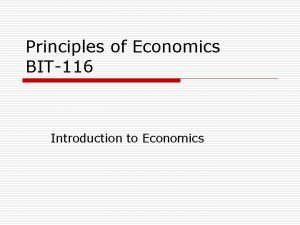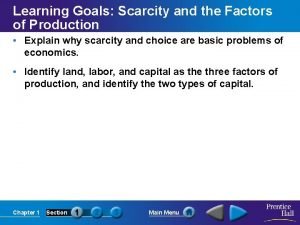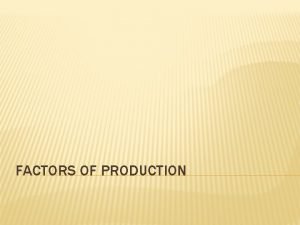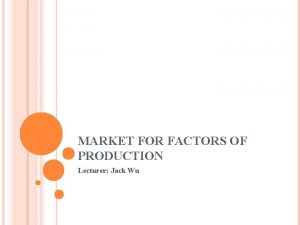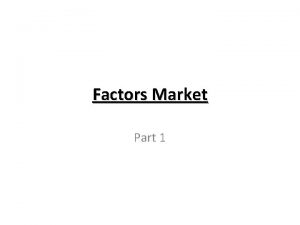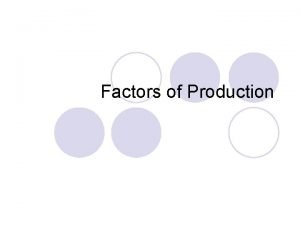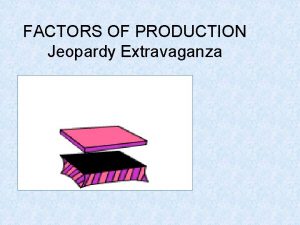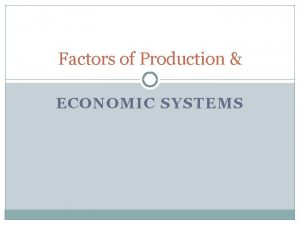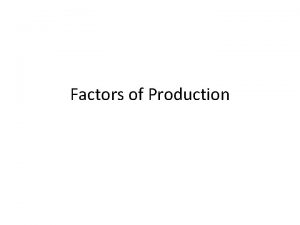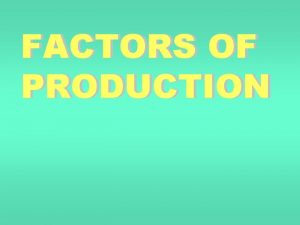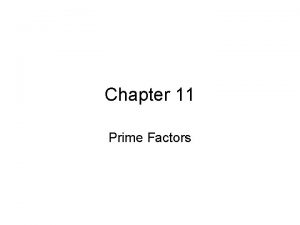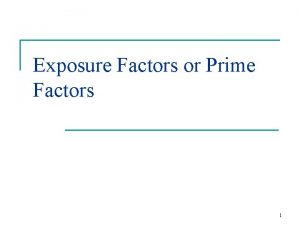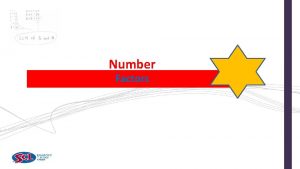MARKET FOR FACTORS OF PRODUCTION Lecturer Jack Wu






















- Slides: 22

MARKET FOR FACTORS OF PRODUCTION Lecturer: Jack Wu

FACTOR OF PRODUCTION Factors of production Inputs used to produce goods and services Labor, land, and capital Factor markets The demand for a factor of production is a derived demand From firm’s decision to supply a good in another market

DEMAND FOR LABOR Labor market Governed by supply and demand Labor demand Derived demand Labor services = inputs into the production of other goods

THE VERSATILITY OF SUPPLY AND DEMAND (a) The market for apples Price of apples Supply P (b) The market for apple pickers Wage of apple pickers Supply W Demand 0 Q Quantity of apples 0 L Quantity of apple pickers 4

DEMAND FOR LABOR Assumptions Firm is competitive in both markets For goods and for labor Price taker Pay the market wage Get the market price for goods Decide Quantity of goods to sell Quantity of labor to hire Firm is profit-maximizing

DEMAND FOR LABOR Production function ³ Marginal product of labor (MPL) ³ Relationship between the quantity of inputs used to make a good and the quantity of output of that good Increase in the amount of output from an additional unit of labor Diminishing marginal product ³ The marginal product of an input declines as the quantity of the input increases

VALUE OF THE MARGINAL PRODUCT OF LABOR (VMPL) Marginal product of labor times the price of the output Marginal revenue product Additional revenue from hiring one additional unit of labor Diminishes as the number of workers rises

HOW A COMPETITIVE FIRM DECIDES HOW MUCH LABOR TO HIRE Labor L Output Q Marginal product of labor MPL=ΔQ/ΔL 0 workers 1 2 3 4 5 0 bushels 100 180 240 280 300 100 bushels 80 60 40 20 Value of the marginal product of labor VMPL=P ˣ MPL Wage W Marginal profit ΔProfit=VMPL-W $1, 000 800 600 400 200 $500 500 500 $500 300 100 -300 8

PROFIT MAXIMIZING QUANTITY OF LABOR Value of the marginal product Market wage Value of marginal product (demand curve for labor) 0 Profit-maximizing quantity Quantity of apple pickers 9

WHAT IS LABOR DEMAND CURVE? Competitive, profit-maximizing firm Hires Value of the marginal product of labor = wage The value-of-marginal-product curve is the labor-demand curve workers up to the point where For a competitive, profit-maximizing firm Labor-demand curve Reflects the value of marginal product of labor

SHIFTING LABOR DEMAND CURVE What causes the labor-demand curve to shift? ³ The output price ® ³ Demand for labor: VMPL = MPL ˣ P of output Technological change Technological advance ¯ Can raise MPL: increase demand for labor ® Labor-saving technology ¯ Can reduce MPL: decrease demand for labor ® ³ Supply of other factors ® Affect marginal product of other factor

LABOR SUPPLY The trade-off between work and leisure Labor-supply curve ³ Reflects how workers’ decisions about the labor-leisure tradeoff Respond to a change in opportunity cost of leisure ® Upward sloping curve or backward sloping curve? ® What causes the labor-supply curve to shift? Changes in tastes ³ Changes in alternative opportunities ³ Immigration ³

EQUILIBRIUM Wages in competitive labor markets Adjusts to balance the supply & demand for labor Equals the value of the marginal product of labor Changes in supply or demand for labor Change the equilibrium wage Change the value of the marginal product by the same amount

EQUILIBRIUM IN A LABOR MARKET Wage (price of labor) Supply Equilibrium wage, W Demand 0 Equilibrium employment, L Quantity of labor 14

CHANGE IN EQUILIBRIUM Increase in supply Decrease in wage Lower marginal product of labor Lower value of marginal product of labor Higher employment

AN INCREASE IN LABOR SUPPLY Wage (price of labor) 1. An increase in labor supply. . . Supply, S 1 S 2 W 1 W 2 2. . reduces the wage. . . Demand 0 Quantity of labor L 1 L 2 3. . and raises employment. 16

CHANGE IN EQUILIBRIUM Increase in demand Higher wage No change in marginal product of labor Higher value of marginal product of labor Higher employment

AN INCREASE IN LABOR DEMAND Wage (price of labor) Supply 1. An increase in labor demand. . . W 2 W 1 2. . increases the wage. . . D 2 Demand, D 1 0 Quantity of labor L 1 L 2 3. . and increases employment. 18

OTHER FACTORS OF PRODUCTION Capital ³ Equipment and structures used to produce goods and services Equilibrium in the markets for land & capital ³ Purchase price ® ³ Price a person pays to own that factor of production indefinitely Rental price ® Price a person pays to use that factor for a limited period of time

RENTAL PRICE Wage – rental price of labor Rental price of land & Rental price of capital Determined by supply and demand Demand – derived demand Reflects marginal productivity of the factor Each factor’s rental price = value of marginal product for the factor

THE MARKETS FOR LAND CAPITAL (a) The market for land Rental price of land (b) The market for capital Rental price of capital Supply P P Demand 0 Q Quantity of land 0 Q Quantity of capital 21

PURCHASE PRICE Equilibrium purchase price Of a piece of land or capital depends on Current value of the marginal product Value of the marginal product expected to prevail in the future
 Lecturer's name
Lecturer's name Proses produksi multimedia
Proses produksi multimedia Jack and the beanstalk character traits
Jack and the beanstalk character traits Jeannie watkins
Jeannie watkins Spe distinguished lecturer
Spe distinguished lecturer Afternoon teacher
Afternoon teacher Photography lecturer
Photography lecturer Lecturer in charge
Lecturer in charge Designation lecturer
Designation lecturer Designation of lecturer
Designation of lecturer Guest lecturer in geography
Guest lecturer in geography Lecturer name
Lecturer name Pearson lecturer resources
Pearson lecturer resources 140000/120
140000/120 Lector vs lecturer
Lector vs lecturer Lecturer in charge
Lecturer in charge Cfa lecturer handbook
Cfa lecturer handbook Lecturer asad ali
Lecturer asad ali Market leader follower challenger nicher
Market leader follower challenger nicher Objectives of segmentation
Objectives of segmentation Principal definition economics
Principal definition economics Factors of production
Factors of production Factors of production pictures
Factors of production pictures




















